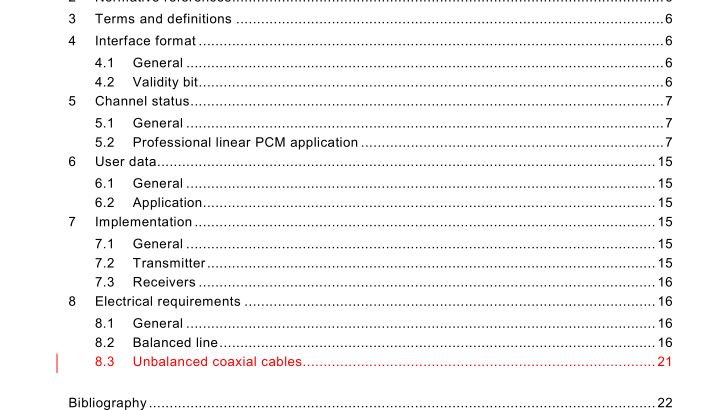IEC 60958-4:2008 pdf download – Digital audio interface – Part 4: Professional applications
1 Scope
This International Standard specifies the professional application of the interface for the interconnection of digital audio equipment defined in IEC 60958-1 .
2 Normative references
The following referenced documents are indispensable for the application of this document. For dated references, only the edition cited applies. For undated references, the latest edition of the referenced document (including any amendments) applies.
IEC 60268-1 2:1 987, Sound system equipment – Part 12: Application of connectors for broadcast and similar use
IEC 60958-1 , Digital audio interface – Part 1: General
IEC 60958-3, Digital audio interface – Part 3: Consumer applications
ISO/IEC 646:1 991 , Information technology – ISO 7-bit coded character set for information interchange
ITU-T Recommendation J.1 7:1 988, Pre-emphasis used on sound-programme circuits
ITU-T Recommendation V.1 1 :1 996, Electrical characteristics for balanced double-current interchange circuits operating at data signalling rates up to 10 Mbit/s
3 Terms and definitions
The terms and definitions given in IEC 60958-1 apply to this part of IEC 60958.
4 Interface format
4.1 General
The interface format as defined in IEC 60958-1 shall be used.
For historical reasons, preambles “B”, “M” and “W”, as defined in 4.3 of IEC 60958-1 , shall, for use in professional applications, be referred to as “Z”, “X” and “Y”, respectively.
4.2 Validity bit
For this standard, the validity bit shall be used to indicate whether the main data field bits in the sub-frame are suitable for conversion to an analogue audio signal using linear PCM coding.
5 Channel status 5.1 General The channel status for each audio signal carries information associated with that audio signal; thus it is possible for different channel status data to be carried in the two sub-frames of the digital audio signal. Examples of information to be carried in the channel status are: length of audio sample words, number of audio channels, sampling frequency, sample address code, alphanumeric source and destination codes, and pre-emphasis.
Channel status information is organized in a 1 92-bit block, subdivided into 24 bytes, numbered 0 to 23 (see Table 1 ). The first bit of each block is carried in the frame with preamble “Z”.
The individual bits of a block are numbered 0 to 1 91 .
The primary application is indicated by channel status bit 0.
For the professional applications described here, this first channel status bit equals “1 ”.
NOTE For consumer digital audio equipment, this first channel status bit equals “0”, and this part of IEC 60958
does not apply .
Secondary applications may be defined within the framework of these primary applications.
5.2 Professional linear PCM application
The specific organization of the channel status data is defined in this clause and summarized in Table 1 .
The significance of byte 0, bit 0 is such that a transmission from an interface conforming to IEC 60958-3 (“consumer use”) can be identified. Also, a “professional use” transmission, defined in this part of IEC 60958, can be correctly identified by a “consumer use” receiver. Connection of a “consumer use” transmitter with a “professional use” receiver or vice versa might result in unpredictable operation. Thus, the byte definitions in this clause apply only when bit 0 = “1 ” and bit 1 = “0” (professional linear PCM use of the channel status block).
